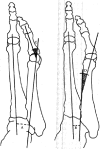From Etiology to Intervention: A Holistic Review of Bunion Pathophysiology and Care
- PMID: 39429503
- PMCID: PMC11489004
- DOI: 10.1155/2024/9910410
From Etiology to Intervention: A Holistic Review of Bunion Pathophysiology and Care
Abstract
In this review paper, we present the common etiology, presentation, diagnosis, and management of the following three common bunion formations: dorsal bunion, tailor's bunion, and hallux valgus (HV). Bunions are common pathologies that present to a variety of clinics, so it is important for providers to have a base understanding of these in order to provide the best care to patients. Many of these bunion formations have a variety of causes which allow providers to manage them before surgical intervention is required. The aim of this review paper is to bring attention and expanded insight on these common bunion presentations in order to minimize morbidity early on. The information provided in this review will allow both primary care and subspecialty physicians with the knowledge to accurately diagnose and optimally manage these bony deformities of the lower extremity.
Copyright © 2024 Danielle Barnes et al.
Conflict of interest statement
The authors declare no conflicts of interest.
Figures




References
-
- Albert A., Leemrijse T. The Dorsal Bunion: An Overview. Foot and Ankle Surgery . 2005;11(2):65–68. doi: 10.1016/j.fas.2004.12.004. - DOI
-
- Park D. B., Goldenberg E. M. Dorsal Bunions: A Review. Journal of Foot Surgery . 1989;28(3):217–219. - PubMed
-
- Kuo K. N. The Clubfoot . New York: Springer; 1993. Reverse Jones Procedure for Dorsal Bunion Following Clubfoot Surgery; pp. 384–387. - DOI
Publication types
LinkOut - more resources
Full Text Sources

